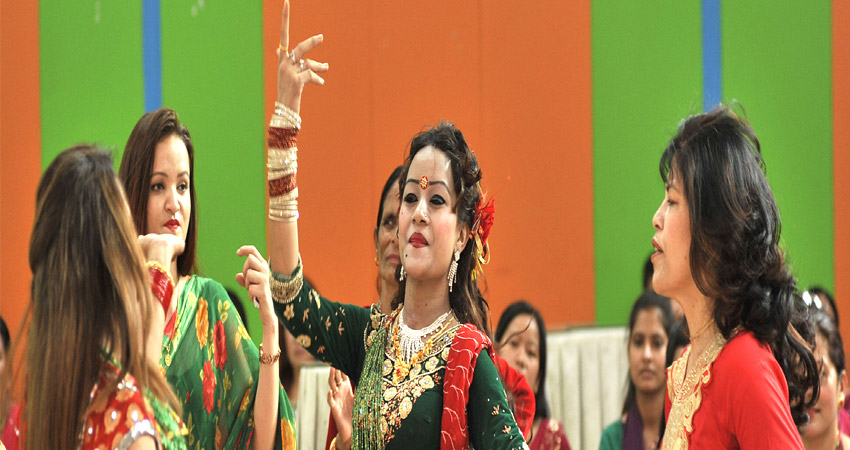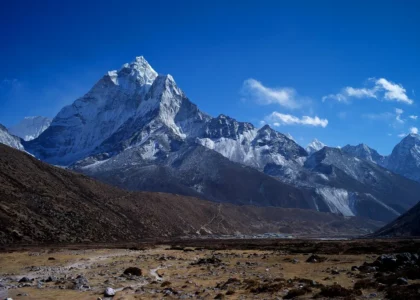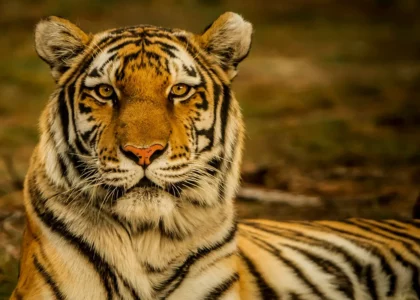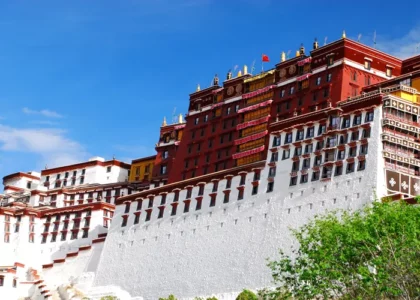Teej festival in Nepal – “The festival especially for Hindu Women.”

About the Teej festival
Nepal is a culturally rich country celebrating many festivals with joy and vibrancy. It is a multiethnic country, and each festival is celebrated uniquely and joyously. Nepal is a land of festivals and offers different festivals with unique features. The Teej festival is one of the famous Hindu festivals celebrated by Nepalese women.
The Teej festival occurs in Nepali Bhadra (August to early September in the solar calendar). It is also known as Haritalika Teej and lasts for three days. During this festival, Hindu women are decorated in red sarees, tika, and bangles, and they sing and dance to traditional folk songs. All women in Nepal celebrate Teej.
This festival is also known as fasting. During the festival, married women fast to pray for the longing of their husbands and a happy family relationship. In contrast, unmarried girls quickly wish for a decent and kind husband like” Lord Shiva” in the Future. This festival is also known as the festival to celebrate happiness among their loved ones. Married women are specially invited to their maternal house by their brothers.
The best festival for Women in Nepal is Teej.
Nepali women celebrate this festival without eating anything, not a drop of water, throughout the day. Teej is celebrated in Nepal in the name of Goddess Parvati to remember her union with Lord Shiva. It is a significant festival celebrated by Hindu women. The word “Teej” comes from a tiny red insect that appears during the monsoon season. Thus, the festival Teej is named after a particular insect.
Haritalika Teej falls on the third day of a full moon in the Hindu month of Bhadra. Watching women of all age groups, old and young, dance for hours under the hot sun without eating food or a single drop of water is fascinating. During these days, they also visit the Shiva mandir, staying in line for long hours and praying about their husbands’ and children’s marital lives. This shows the bravery of Nepalese women.
Importance of Teej
The festival Teej is dedicated to Goddess Parvati due to the historical myth that she was reunited with Lord Shiva on this day. As the festival is also called the fasting festival, women of different ages fast for the well-being of their husbands, children, and the happiness of the entire family by the married women while unmarried women quickly get a decent husband like lord Shiva in their upcoming Future.
Not only this, but this festival also increases the sisterhood among women and shares happiness and love. Nepali women celebrate Teej as a way to be united and have fun with their loved ones. Besides, celebrating Teej has also become a way to bring women of different classes together and celebrate happily. It is said that a woman’s ultimate sacrifice on the day of fasting makes her married life successful.
As per the Hindu myth, Lord Shiva accepts Goddess Parvati as his wife on her 108th birthday, which indicates that Goddess Parvati had to take delivery 108th times. Also, she keeps unsparing fast all her life to please lord Shiva for being granted the wish of being Shiva’s wife by Lord Shiva Himself.
This is why Goddess Parvati is known as “Teej Mata,” meaning “Goddess of Teej.”
Celebration of Teej
Teej is usually a three-day festival with vibrant energy. During this time, women are decorated with red Sarees and bangles, sing traditional Teej songs, and dance in the street, enjoying themselves a lot. Teej is also celebrated in India, but in different ways.
The first day of Teej is known as “dar day,” when all married women are specially invited to their maternal house or picked up from their homes to celebrate this joyous moment and are served lots of delicious food. The next day is the fasting day, and the last day of Teej is known as Rishi Panchami Day. Teej has gained popularity since its start.
Watching all the ladies decked in red clothes, gathering old and young, sustaining the entire day without a single drop of water, not caring about the hot sun or downpour, is intriguing.
Let us describe the Three days of the Teej celebration in detail:
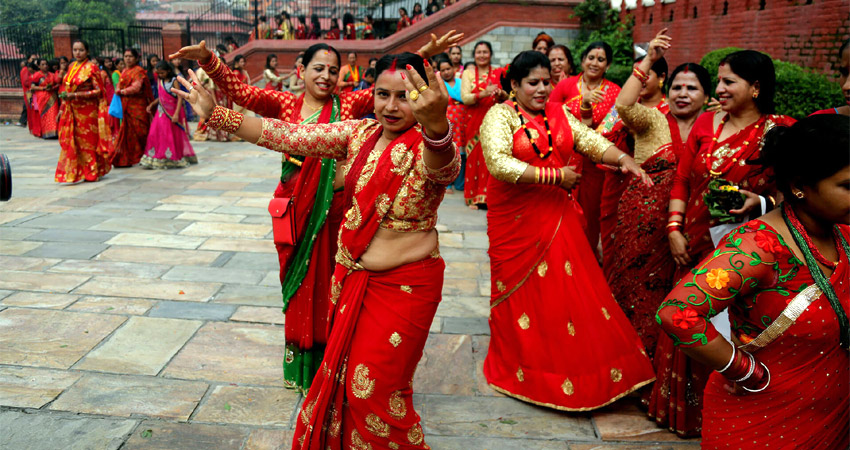
First Day: The Feast Day
“DAR KHANE DIN”/feast day is the name given to the first day of Teej. On this eve (dar khane din), all the relatives, acquaintances, siblings, wedded and unmarried girls are gathered at one spot and celebrate these days with singing, dancing, and having delicious food. In this, women are decked in elegant dresses and jewelry or any of the best Red outfits and share their happiness.
That night, they sang Nepalese folk and Dohori songs with loud tunes and danced, forgetting all the stress of life that increased their sisterhood.
The elegant dress shows the woman as a princess. The dining experience of this night was excellent and enjoyable, with a fantastic blowout called “dar.” It is so-called as the women taking fast the next day feed themselves with an enormous amount of food called “Daro khana” in Nepali.” Daro khana” means substantial nourishment.
That is why the name Dar is involved. On that day, women eat until noon. After that, they will last for a continuous 24 hours. They are invited to their parents’ house to celebrate happiness.
Teej festival is celebrated throughout the country.
The women decorate themselves in Sorhasingaar, wearing elegant clothes, heavy makeup, and dazzling jewelry. They sing devotional Teej songs and start dancing to the cultural tune. With a grand feast party with various foods, desserts, and beverages. Based on their choices, we can have desserts, Nepali food like kheer and sel roti, and other non-veg products such as mutton, chicken, etc.
Today, women express their freedom to work and dedicate all their time to their husbands and family for their entire life. This is the day for women to enjoy their time with their close ones, friends, family, and relatives and eat delightful dishes. The traditional Teej songs are made for women by depicting the pain in their daily lives and their struggles throughout their lifetime. The feast and celebration go till midnight and then fast start for 24 hrs.
Second Day: The Fasting Day
The second day of the Teej festival is the first day, called a fasting day. The women take a very firm and strict fast without drinking a drop of water. It is believed that Goddess Parvati has done the same for being grated as Shiva’s wife. These days, women take an early morning bath. Afterward, wear an elegant dress with jewelry, do full makeup, and visit the holy temple of lord Shiva. It also makes her wish fulfilled. Some women will have fruit and liquid after worshiping Lord Shiva. At the same time, others keep their fast throughout the day without food or even a drop of water.
Today, women wear their best attire, especially red saris, and visit the nearby Shiva temple. They offer prayers with flowers, fruits, sweets, and coins there. They also dance and sing and have fun with other women. The majority of people visit the Pashupatinath temple on this day.
To avoid crowds, many people visit their nearest Lord Shiva temple. Unmarried women keep fast, wishing for a good husband and a happily married life. On this day, married women cheerfully dress in red sari and lehenga, along with their Lagan Ko Pote, Nathhi, other adornments, and Chhadke Tilahari (which are considered most essential for married women) and visit a close-by Lord Shiva’s sanctuary singing and moving the whole distance.
Women keep fasting for the peace and prosperity of the family.
Married women keep this fast, keeping themselves away from food and drinks. They believe their devotion to God will provide them with a long life. And also for the peace and prosperity of the husband and whole family. It is in the hope that the light of an oil lamp all night will bring peace and prosperity to the entire family.
According to traditional belief, the women break their fasting after worshiping their husbands at night. It is also said that they used to drink leg water, “Khutta Doko pain” of their husbands, and fed by their husbands. But nowadays, this trend is not followed by many people. Some women only eat fruits, drink water, and drink milk on this day to complete their Teej Barta after attending “Panchamipuja.”
Third-Day: Rishi Panchami
The final day of the Teej festival is known as Rishi Panchami, which is dedicated to Saptarishis (seven sages). Women worship seven sages after completing the puja of the previous fasting day.
In the early morning, before the sun rises, they bathe with leaves and red mud found on the roots of the sacred Datiwan (holy tree) bush and pray for the deities. They also brush their teeth with Datiwan (branches of a bush tree), hoping this purifies their body and soul.
This day is significant as it believes bathing is associated with all rituals. Baths act as a way of purification that discharges women for their sins. People think this day is a day to seek forgiveness.
Both married and unmarried Hindu women and girls who have experienced their first menstruation cycle should attend Rishi Panchami. On this day, women also fast until they complete their rishi Panchami puja. Hindu women and girls keep fasting on this day to ask forgiveness from the seven saints for any mistakes they have made knowingly or unknowingly during the time of their menstruation.
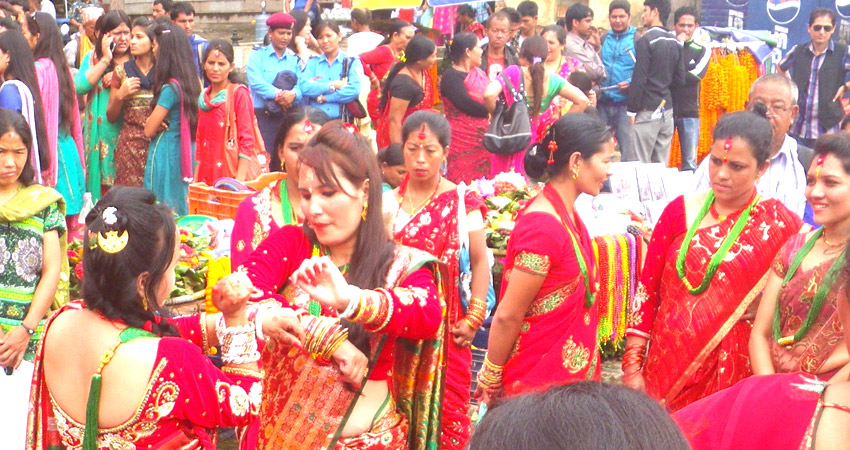
Conclusion of Teej
We all know that about 51% of Nepal’s population is women. Thus, the Nepal government declared it public for women to celebrate this festival on this day. Hence, it is one of the biggest celebrations in Nepal. Women ask for special blessings from Lord Shiva to have a decent husband and pay for his longevity and prosperity.
However, in recent years, this festival has influenced many Nepali women scattered all over the world. Due to the recent digitalization, the show-off trend is increasing in the festive period as rich women show off their luxurious ornaments and post their pictures on social media. This is becoming the most significant reason to celebrate the festival.
Not only this, but traditional Teej songs have also been replaced by new Westernized music. This is not a good way, but if it goes, the day is not so far that our traditional culture will vanish. We need to respect and preserve our culture and festivals.
Reason for celebrating Hartalika Teej
Nepal celebrates Teej as its biggest holiday because of its traditional beliefs. The celebration of Teej and Rishi Panchami was based on a wide range of religious ideals and principles.
According to Hindu mythology, Shree Swosthani Bratakatha, goddess Parvati, and her friends left their house and headed for the forest because she was worried that her father, Himalaya, would commit to Vishnu and marry his daughter Parvati. She then went to the forest and prayed to Shiva to grant her request to marry him.
He promised to grant her desire when he stated “tathastu.” On Teej Day, Parvati finally fulfilled her lifelong dream of marrying her beloved. Therefore, single women celebrate this day in hopes of finding the spouse of their dreams, while married women celebrate it in hopes of their husbands living long, healthy lives.
Ladies fast on Teej and worship Lord Shiva, hoping that single women will find a spouse like Lord Shiva. On the other hand, they married women quickly for their husbands, who would live long and fruitful lives. Since Lord Shiva and Parvati’s reunion is celebrated on Teej, it holds religious significance.
On Teej, married women adore their husbands as gods. After a strict fast, they receive their husbands’ first bite of food and water. Then, they prostrate themselves at their husbands’ feet for blessing.
The festival is celebrated for the happiness of spouses and kids and the cleansing of one’s spirit and body. It is dedicated to Parvati and honors her marriage with Shiva. A festival is a three-day event that includes lavish feasts and strict fasting. Women celebrate Teej (sometimes spelled Tij) to keep their husbands’ long lives and enduring marriages in this world and all future lifetimes. On the third day following the new moon of the month of Bhadra (mid-August to mid-September), it is mainly honored by women from different castes in Nepali culture, specifically the Chettri, Bahun, Kiratis, and others.
Teej has ancient and modern significance as a festival of enjoying time with siblings, and in certain areas, it is known as a “festival of sisterhood.” Although it appears to be a celebration of sisterhood because married women have limited opportunities to see their birthplace sisters and friends, brothers play a significant role in the festival, as they call their sisters on this auspicious occasion and prepare exceptional food for them. All the girls also spend time getting ready to look their best and dancing to forget their in-laws’ discomfort, expressed in folk dance and songs.
Method of celebrating Haritalika Teej
Women beautify themselves like brides by wearing heavy antique ornaments and bright traditional clothing. Women assemble to enjoy the meal by calling their female friends, family members, and neighbors. They then sing and dance while taking in the festivities. They often exchange presents to show each other their affection and happiness.
Even though Pashupatinath Temple is where most women in Nepal celebrate Teej, some do it at home or a nearby Shiva temple. After paying respects to Lord Shiva, one can gather in the privacy of one’s own home with one’s sisters and friends. During Teej, married ladies are invited to their mothers’ houses. The mother and daughter might use it to justify spending time together and having fun.
They dance, play instruments, and sing traditional songs. During Teej, being at home with your loved ones is enjoyable and joyful. Having fun together may help you forget your tension and improve your connection with them. Sing bhajans in honor of Lord Shiva and Parvati with them, and at night, listen to the holy Lord Shiva’s tales to feel peaceful and committed.
Why do women wear red during the Teej festival?
In Nepal, married ladies wear red exclusively. Although everyone can wear red whenever they wish, red has special significance in Nepali culture and tradition in Teej. For married ladies, red is regarded as a “Shubha,” or fortunate color. In keeping with Hindu custom, a woman wears red at her wedding. The male applies red vermillion powder to the woman’s forehead during the marriage ceremony. A married lady typically dresses in red, whether a tika, a necklace, bangles, or clothing after marriage.
As a result, they dress in red during Teej to resemble brides. Women are eager to purchase new clothing and accessories to wear during Teej. Red, yellow, and green are occasionally combined to enhance their attractiveness. They also favor applying Mehendi to their hands, another ornament for married and single ladies.
Importance of Pashupatinath Temple on Teej
The Pashupatinath Temple is one of Nepal’s most renowned and historic sites. It is filled with hope and good vibes. It is also said that the deity Shiva’s avatar previously resided there. So many female worshipers of Lord Shiva come to the temple. Married and single ladies in red, who are energetic and enthusiastic, beautify the historic Pashupatinath shrine.
This revered temple is the first choice for ladies to worship Lord Shiva during the Teej festival. On this day, red becomes the dominant color, and Nepali ladies will try to be as joyful as they can be to catch Shiva’s eye. In Hindu mythology, Pashupati is a representation of Lord Shiva in the form of an animal. People come to this revered temple to worship Lord Shiva and offer prayers for their families’ happiness and health. Thousands of Nepali women go to the Pashupatinath temple during the Teej Festival. On this auspicious occasion, they worship and dance for the entire day.
What Can Tourists See?
In Kathmandu, devotees might wear emerald-colored clothing and admire spectacular scenery during Teej. The Goddess Parvati (Teej Mata) idol is shown throughout the ceremony. In addition to singing and dancing, many ladies may be observed worshiping the deity everywhere, even on the street and in homes.
The world’s population may find these activities exciting and appealing. Nowadays, tourists are always looking for something new while trying to learn about the culture and religion of the nation. Visitors may view it and take pictures of it. As time passes, non-Hindus and visitors from other countries can also participate in the amusing celebration. Additionally, the Gai Jatra and Nepal Kumari Festivals will likely occur during your stay in Nepal in August or September.
If you’re interested, you may join them in celebrating, which can add excitement to your trip to Nepal. The Teej festival will be celebrated in Nepal on September 18, 2025.
This is the ideal time for tourists outside Nepal to learn about its customs and culture. If this article piques your interest and you wish to participate in the Teej festival there, you can travel to Nepal in August or September during the holiday season.
Dates of Haritalika Teej in Nepal
Year Day Month Holiday
2024 Fri, September 6 National Holiday
2023 Mon September 18 National Holiday
2022 Tue August 30 National Holiday
2021 Thu, September 9 National Holiday
2020 Fri, August 21 National Holiday
Importance of Rishi Panchami
Rishi Panchami is a national holiday and a traditional Hindu celebration in Nepal. All women participate, as do girls who have had their first period, asking for forgiveness for any mistakes made during their periods. The dates of specific past, present, and upcoming Rishi Panchami celebrations are provided.
Year Date Day Holiday
2022 August 31 Wed Rishi Panchami
2021 September 11 Sat Rishi Panchami
2020 August 23 Sun Rishi Panchami
2019 3 Sep Tue Rishi Panchami
2018 14 Sep Fri Rishi Panchami
2017 August 26 Sat Rishi Panchami
2023 19 Sep Tue Rishi Panchami
2024 8 Sep Sun Rishi Panchami
2025 August 28 Thu Rishi Panchami
2026 September 16 Wed Rishi Panchami
Rishi Panchami falls on September 1 this year. In Hinduism, it is a significant holiday. Hinduism observes it as a celebration and a momentous occasion.
The festival of Rishi Panchami is observed on the fifth day of Shukla Paksha in the Hindu calendar month of Bhadrapada, the day after Ganesh Chaturthi. The Sapta Rishis are traditionally worshipped this way, and on this day, respect is shown for them. The goal of this fast is to honor the outstanding achievements of those ancient sages or gurus who dedicated their lives to the betterment of society and to express respect, thanks, and memory for them.
The seven gurus are Kashyapa, Atri, Bharadwaja, Vishwamitra, Gautam Maharishi, Jamadagni, and Vashishtha. This day is also observed as Vishwakarma Puja in various areas of Kerala. On the day of Rishi Panchami, one can obtain forgiveness for sins consciously or unconsciously by fasting. It is also essential to bathe in the holy rivers on this day.
Worship regulations for Rishi Panchami
Men and women should observe this fast to atone for any unintentional sins they may have committed. In India, the fasting individual should bathe in the Ganga river or any other pond. If this is impossible, you should take a bath at home by combining Ganga water with bathing water. Make an urn from mud or copper water, then clean the cow manure before creating Ashtadal Kamal. As you listen to the tale, worship the Sapta Rishis, including Arundhati, and feed the Brahmins before devouring it for yourself.
However, there is a slight difference in how Rishi Panchami is celebrated in Nepal. On Rishi Panchami, women bathe ceremonially in holy water, whether in a river, pond, or other body of water.
They bathe before sunrise, cover themselves in sure mud, wash their teeth with Datiwan herb; present Datiwan leaves to the gods, and fast throughout the day. They may also do numerous additional religious practices, such as washing their husbands’ feet.
Numerous Hindu deities are adored on this day. Among them are the Sapta Rishi, often known as the “seven sages,” who are said to reside in the Great Bear Constellation. On Rishi Panchami, images of these seven gods and other gods can be created from cow dung.
FAQs
What is the purpose of the Teej festival?
According to Indian mythology, Hariyali Teej—known as Teej Mata on this day—celebrates Lord Shiva’s and Goddess Parvati’s merger. On this auspicious day, women pray for a happy marriage and the welfare of their families.
Where in Nepal is Teej celebrated?
Even though most women in Nepal celebrate Teej at Pashupatinath Temple, some do it at home. During the day, they visit a nearby Shiva temple to worship Shiva. After paying respects to Lord Shiva, people can assemble with their sisters and friends in the privacy of their own homes. During Teej, married ladies are invited to their mothers’ houses.
What does Teej mean?
Married and single ladies celebrate this Teej festival only to obtain Goddess Parvati’s and Shiva’s blessings. It is observed on Tritiya, the third day of the Shukla paksha, in the Hindu month of Bhadrapada.
Is Teej for married Women?
It is said that Parvati fasted and prayed to Lord Shiva for an entire day. She pleased Lord Shiva, who took her as his wife due to her devotion. Parvati married Lord Shiva in a traditional ceremony with her father’s blessing. As a result, both married and single Hindu women participate in the annual Hartalika Teej celebration. While unmarried girls hope for a perfect and devoted spouse, married ladies pray for their husband’s long life and wealth.
How can I break my Teej fast while I’m in Nepal?
Women break their fast on the festival’s third day, which is its last day. Rishi Panchami is the name of this day. The ladies do the Rishi Sapta puja before breaking the fast, a tradition that has been carried on for more than 750 years. They can break their fast by consuming water, fruits, and cooked vegetables. Nepal trekking season starts at this time of the festival. You can consider the Everest base camp a short trek to go on.
Best Price Guaranteed, Easy to change Date, Instant Confirmation
Book This Trip Have Questions?
Have Questions?Talk to Expert
Meet Mr. Purushotam Timalsena (Puru), Nepal's best trek and tour organizer, who has been working in the Himalayas for more than 24 years.
WhatsApp/Viber +977 98510 95 800
